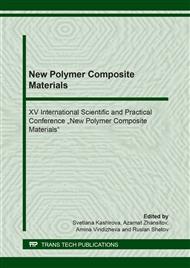[1]
W.J. Van Ooij. Мechanism and theories of rubber adhesion to steel tire cords - an overview, Rubber Chemistry and Technology. 57 (3) (1984) 421-456.
DOI: 10.5254/1.3536016
Google Scholar
[2]
T. Hotaka, Y. Ishikawa, K. Mori. Effect of compound ingredients on adhesion between rubber and brass-plated steel cord, Rubber Chemistry and Technology. 78 (2) (2005) 175-187.
DOI: 10.5254/1.3547876
Google Scholar
[3]
X. Shi, M. Ma, C. Lian, D. Zhu. Investigation of the effects of adhesion promoters on the adhesion properties of rubber/steel cord by a new testing technique, J. Appl. Polym. Sci. 131 (3) (2014) 205-217.
DOI: 10.1002/app.39460
Google Scholar
[4]
Y. Chen, J.L. Schlarb Steel cord-rubber adhesion with SEM/EDX, Tire Science and Technology. 46 (1) (2018) 27-37.
DOI: 10.2346/tire.18.460102
Google Scholar
[5]
Kasperovich A. V., KrotovaO. A., PotapovE. E., Reznichenko S. V., Shkodich V. F. A Study of the Influence of a New Promoter on the Adhesion of Rubber to a Metal Cord, Polymer Science Series D. Glues and Sealing Materials. 9 (1) (2016) 68–71.
DOI: 10.1134/s1995421215040061
Google Scholar
[6]
H.J. Hennig, S.Stammheim, O. Bayer. USA patent №3379749, 23.04.(1968).
Google Scholar
[7]
Aznabaev R. N., Shishkina N. N., Zakirova L. U., Zakirov M. E.. Synthesis of 2,4 difenilkarbami-dotoluene and its use for modifying the rubber, Butlerov Communications. 48 (I. 12) (2016) 133-137.
Google Scholar
[8]
Barton D., Ollis U. Comprehensive organic chemistry, V.3, Himiya, Moscow, (1982).
Google Scholar


